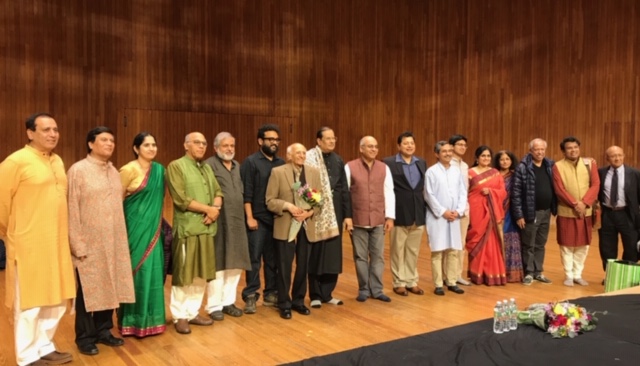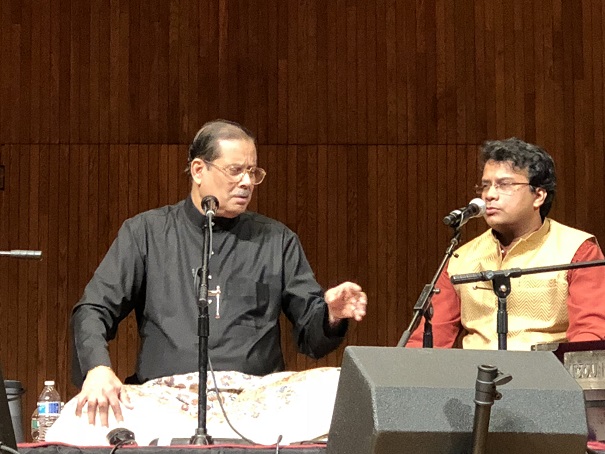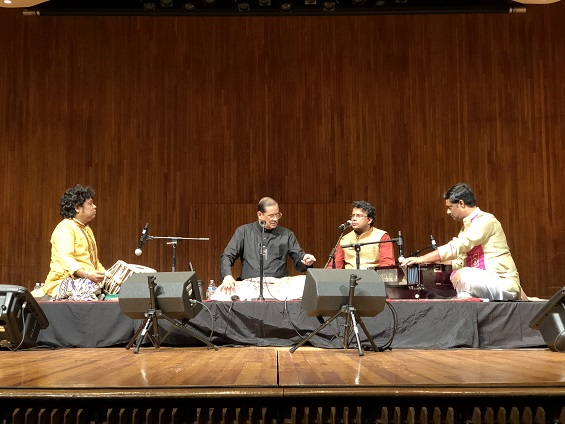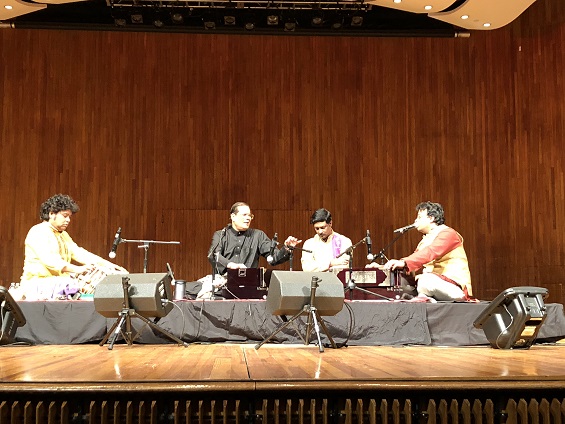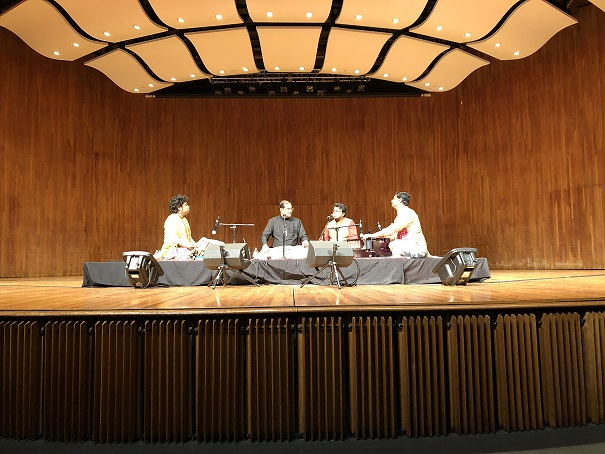Contribute
| Rich Variety Of Musical Genres Presented In Hindustani Concert |
Shuchita Rao
11/08/2018
MIT’s Kresge auditorium came alive with Padmashree Pandit Ajoy Chakrabarty’s rich offering of Hindustani classical and semi-classical music on the evening of Saturday, November 3, 2018 in a melodious concert organized jointly by non-profit organizations MITHAS, Prabasi and LearnQuest Academy. Pandit Chakrabarty was supported with great sensitivity on the tabla by Shri Soumen Sarkar and on the harmonium by Shri Gourab Chatterjee and Shri Anol Chatterjee. Anol, a popular television artist of West Bengal additionally provided brilliant vocal support during the three and half hour long concert. Having learned music from renowned musicians such as the late Padmabhushan Pandit Jnan Prakash Ghosh and the late Ustad Munawar Ali Khan (son of the legendary musician Ustad Bade Ghulam Ali Khan), Pandit Chakrabarty, a leading exponent of the Patiala Gharana has the dual distinction of being a performer and educator. He has taught at the premier music institution Sangeet Research Academy located in Kolkata and is also the founder of the Shrutinandan school of music for musically gifted young children also based in Kolkata. Kaushiki Chakrabarty, a product of Shrutinandan and currently a top ranking, versatile female Hindustani vocal exponent is the daughter of Pandit Chakrabarty and Smt. Chandana Chakrabarty. The first half of the November 3rd concert was devoted to the classical rendition of Raga Kalyan. Pandit Chakrabarty systematically explored closely allied ragas such as Bhoop, Shudh Kalyan and Yaman Kalyan in slow and medium tempo through popular khyal compositions such as “Chandrama Lalat†and “Darshan Devo Shankar Mahadev†describing a central deity of the Hindu religion, Lord Shiva. Slow and leisurely alaap development was followed by rigorous gamak taans and contrasted with delicate gliding ornamental movements (meend) in this rendition. Pandit Chakrabarty modulated his voice well and showed immense possibilities of creative development of the ragas belonging to the Kalyan family. The concluding piece of the classical segment, a Yaman Kalyan tarana in faster tempo sixteen beat rhythm cycle teentaal was marked by crisp delivery of several fast sargam (solfege patterns), aakaar taans (rapid melodic movements sung using the “aa†vowel sound) and layakari (play with rhythm). The second half of the concert was significant for the breadth and scope of a range of semi-classical compositions presented. The songs that were presented were “Ras Ke Bhare Tore Nain†a Bol-Banaav thumri of Banaras (Poorab Ang) based on Raga Mishra Tilang and the thumri “Aaye Na Baalam Ka karoon Sajni†popularized by Ustad Bade Ghulam Ali Khan, Bandish ki Thumri “Koyaliya Kook Sunaaye†based on Raga Khamaj where Panditji imitated the sound of a Koyel bird, Bengali love song based on Raga Piloo, Shyama Sangeet based on Raga Bageshri, Western Jazz composition based on Raga Kirwani and a devotional composition in Raga Bhairavi. The semi-classical compositions meandered through several beautiful ragas and displayed Pandit Chakrabarty’s uncanny command on sur, laya and bhava (expression). The love song “Piya Bholo Abhiman†composed by the late Pandit Jnan Prakash Ghosh in Raga Piloo had touching lyrics rendered with great feeling. Piya bholo abhiman, modhu raat boye jaayi | Pandit Chakrabarty paying tribute to the musical genius of his teacher Pandit Ghosh for this beautiful composition translated the lyrics for the benefit of the audience. “My dear friend, my favorite friend, please forgive me. The sweetest night is passing by. Please maintain our friendship and come to me.â€
O go katha kichchu bolo
Dure thaka kigo saaje
Maya bhora jochchonay |
Before singing the next composition in the Western Jazz style, Pandit Chakrabarty said “Indian music is the highest form of music in the world. While it is easy for an Indian musician to sing music of any kind, it is very difficult for other musicians to sing Indian musical phrases.†Pandit Chakrabarty then demonstrated singing all the twelve notes of an octave in a rapid descending manner and also demonstrated with perfect ease the use of scat phrases with high notes of the upper vocal register. Imaginative percussion support by Shri Soumen Sarkar on the tabla was fitting for the Jazz style song.
You may also access this article through our web-site http://www.lokvani.com/
